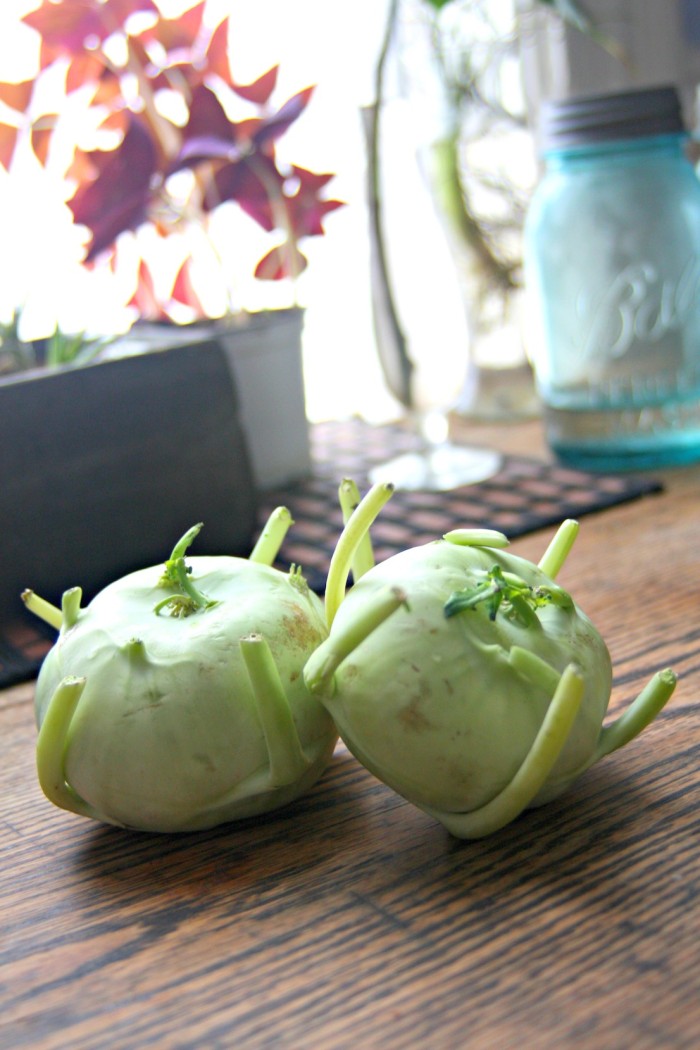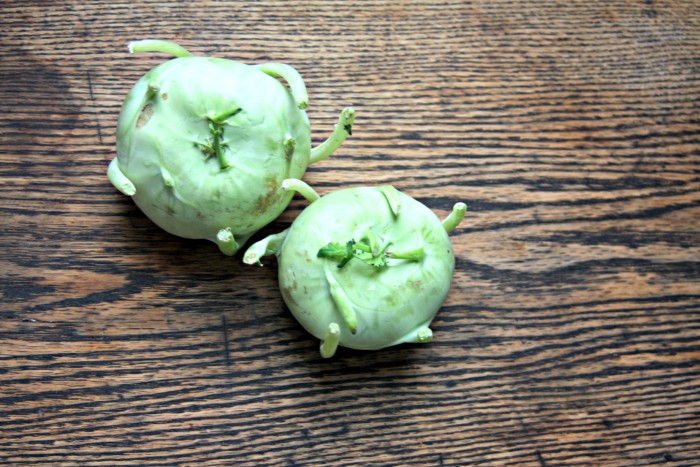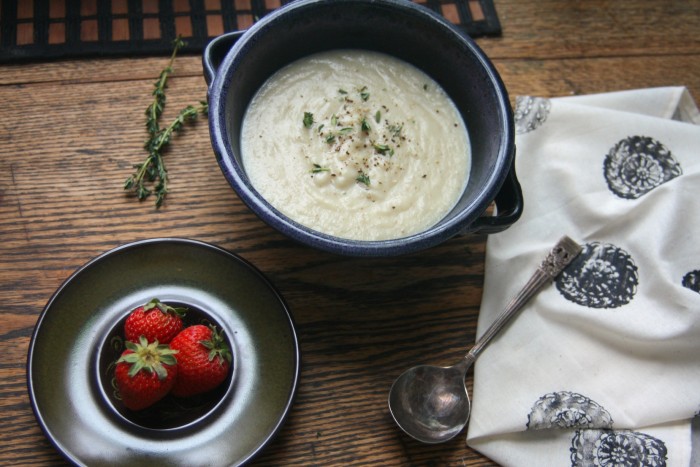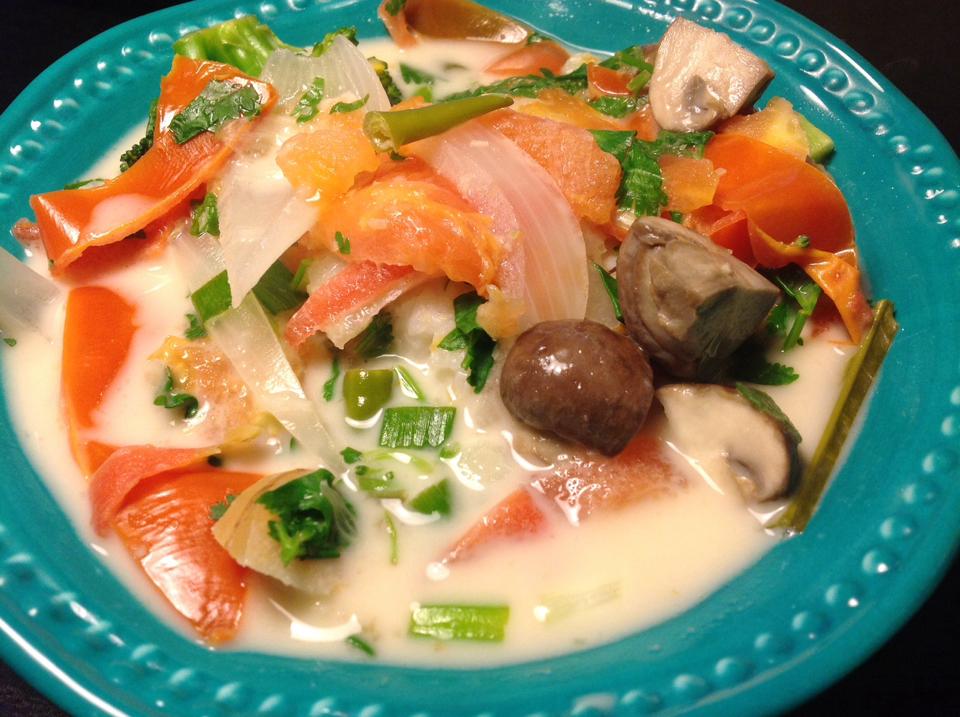Chances are, you’ve already encountered this little garden alien / vegetable at the farmer’s market. If it’s already not a part of your grocery shopping routine, here are some benefits of kohlrabi and easy ways to prepare it!
What is Kohlrabi?
The name Kohlrabi comes from the German Kohl, which means cabbage, and Rübe, which means turnip. It is a common ingredient in German cuisine. Kohlrabi is a member of the Brassica family, so it is a cousin to cabbage, broccoli, and kale. The skin of this funky food can range from purple to light green and white. The meaty part underneath the skin is usually white. The whole plant is edible, but most people eat the bulbous part that grows just above the soil. The greens are yummy so don’t throw them away! You can sauté them or eat them raw. In fact, the bulb can be eaten raw or cooked as well.
Why should you eat it?
This under-appreciated garden alien Brassica is a good source of B-vitamins niacin, thiamin, folate, and vitamin B6. It is also packed with vitamin C, manganese, copper, and potassium. Kohlrabi is one of those vegetables that is low calorie but actually makes you feel full after eating it! It has a very mellow, slightly peppery flavor, something like if a cucumber and a cabbage made a little veggie-babe. It is slightly crispy and would work well in slaws and spring rolls if eaten raw.
One cup of kohlrabi has 36 calories and most of them are from carbohydrates. This high percentage of carbs ensures we get a boost of energy. Three of it’s eight grams of carbs come from sugar, though the high content of vitamins and minerals present makes this veggie more of a friend than foe. Kohlrabi is one of the least known, but healthiest, foods so take advantage of this nutritional powerhouse!
How do you prepare it?
When you buy kohlrabi, make sure to pick bulbs that are firm. If you can, find some with the leaves still attached. Kohlrabi has a tough outer skin that can be unpleasant to eat. Make sure you peel it off before cooking. I have found that it’s easiest to cut the bulb into four wedges and peel each one individually. If the plant is young enough the skin might not be so tough, but when you cut it open it’s usually easy to see where the toughness ends and the softer part begins.
Kohlrabi can be prepared in many ways: roasted, steamed, boiled, or just eaten raw, marinated and tossed in a salad. I also like to shred it and make fritters or use it as a creamy base for a soup along with potatoes.
To Roast:
Toss with olive oil, minced garlic, and salt and pepper to taste. Bake for 20 minutes at 450 F.
To Steam:
Place kohlrabi wedges in a saucepan with an inch or so of water and salt and pepper to taste. Cover and steam for about 10 or 15 minutes. Drain any leftover water and toss with olive oil and herbs.
To Boil:
Boil slices for 10 to 15 minutes or 20 to 30 minutes if you like it cubed. Drain and season with salt and pepper.
To Marinate:
Whisk together lemon zest and juice, honey, olive oil, herbs and minced sweet onion. Pour over kohlrabi slices, season with salt and pepper, and let marinate for 30 minutes to overnight. Toss with some greens when ready to eat.
Raw:
Slice thinly on a mandolin and drizzle with olive oil and lemon juice. Shred and use in a slaw. Chop into matchsticks and use in a salad. Make kohlrabi chips. The possibilities are endless!
How do you store it?
Kohlrabi will be okay left out on the counter for up to 1 week. The tops should be cut off and used immediately because they continue to draw up moisture from the bulb.
~
Here’s a quick and easy recipe to try!
Kohlrabi and Potato Cream Soup
This soup is perfect for springtime, when days are still cool and you are transitioning from the heavy soups of winter. It’s light and creamy, at the same time being filling and delicious. Get creative with this recipe! Use parsnips instead of potatoes. Get those onions nice and caramelized. Add kale! Soak up with some homemade bread and finish off with a sweet little treat.
This recipe is pretty basic. Two kohlrabi bulbs, two potatoes, onions and garlic are the main players. Boil kohlrabi and potatoes together, roast onions and garlic in olives oil, and blend it all together with vegetable broth. You can do this with an immersion blender on the stove or in a big blender if you have one. Or just blend in batches. Simmer on the stove to blend flavors and season with salt, pepper, and herbs. Eat and enjoy!
2 kohlrabi bulbs, diced
2 potatoes, diced
1 onion, sliced thickly
5-6 cloves garlic, whole
1 TBSP olive oil
1.5 cups vegetable broth
1. Preheat the oven to 475 F. Toss onions with olive oil and roast in oven for 15 minutes. At the 15 minute mark, add garlic and continue to roast until onions are roasted to your liking.
2. While onions are in the oven, combine kohlrabi and potatoes in a pot and add water to just cover the vegetables. Boil until soft (10-15 minutes, depending on size)
3. Blend together kohlrabi, potatoes, onions, and garlic with a little vegetable broth. Add the rest of the broth and blend until smooth.
4. Pour into a saucepan and simmer for 5-10 minutes to blend flavors. Season with salt and pepper, garnish with your favorite herbs.
~
Kohlrabi is filled with vitamins and minerals and has such a mellow flavor that it’s a wonder more people don’t eat it. Granted, it’s a funny looking vegetable, and requires some preparation, but it is so versatile. If you’ve never tried kohlrabi, head down to your farmers market and pick some up. Or, if you like to grow your own veggies, it’s pretty low maintenance and makes for a unique addition to your garden.
Would you give kohlrabi a chance? Let me know 🙂
Related: Benefits of Beets + 3 Easy Recipes
Benefits of Carob + Raw Carob Cherry Brownie Recipe
Benefits of Jicama + Jicama Smoothie Recipe
__
Photo: Bethany Cox







